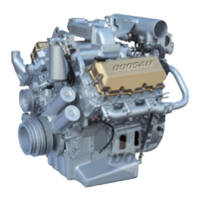DV11
Operation and Maintenance
116
Common Rail Fuel-injection System
Printed in Mar. 2005 PS-MMA0608-E1A
3.4.2. Major components of the common rail system
1) Electric control unit(ECU)
2) Crankshaft speed sensor
3) Camshaft speed sensor
4) Accelerator pedal sensor
5) Fuel temperature sensor
6) Boost pressure and temperature sensor
7) Common rail pressure sensor
8) Coolant temperature sensor
9) oil pressure and temperature sensor
z Using the input signals from the above sensors, the ECU registers the driver's
requirements(accelerator pedal setting) and defines the instantaneous operating
performance of the engine and the vehicle as a whole. On the basis of this
information, it can then intervene with open and closed-loop controlling action at
the vehicle and particularly at the engine.
z The engine speed is measured by the crankshaft speed sensor, and the camshaft
speed sensor determines the firing sequence (phase length). The electrical signal
generated across a potentiometer in the accelerator pedal module informs the
ECU about how far the driver has depressed the pedal, the engine is equipped
with a turbocharger and boost pressure control, the boost pressure sensor also
measures boost pressure.
z At low outside temperatures and with the engine cold, the ECU applies the data
from the coolant temperature and air temperature sensors to adapt the set point
values for start of the particular operating conditions.
3.4.3. Injection characteristics with common rail
z Injection characteristics with common rail, compared to conventional injection
characteristics, the following demands are made up on an ideal injection
characteristic, Independently of each other, injected fuel quantity and injection
pressure should be definable for each and every engine operating condition.

